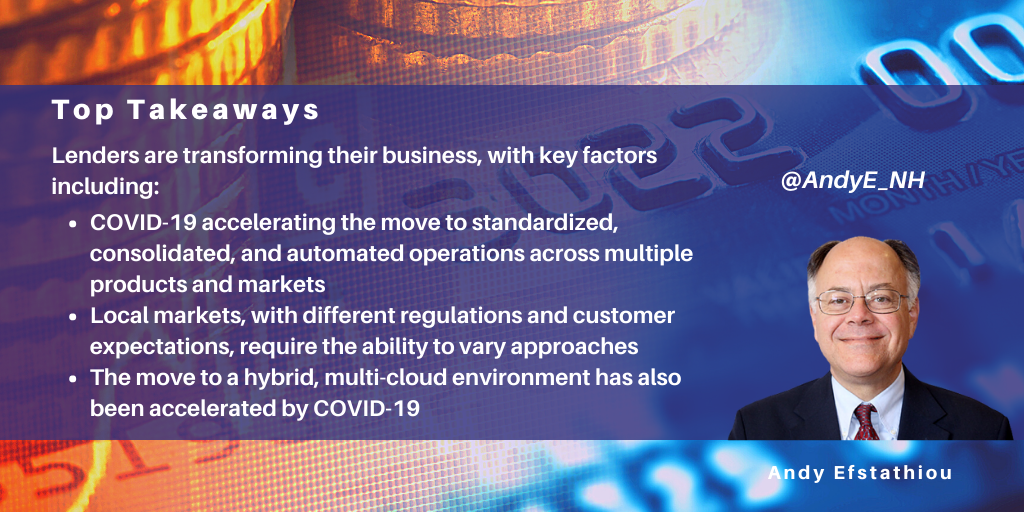posted on Jul 28, 2020 by Andy Efstathiou

NelsonHall recently completed a market assessment and forecast report on Transforming Mortgage and Loan Services. We found that the lending industry is undergoing profound operational change as it adapts to slowing loan growth and emerging customer populations that are younger and more technology savvy. For the past two years, lenders have been:
- Variablizing and reducing the cost of operational delivery using automation, AI, and third-party operations delivery
- Moving to hybrid cloud delivery. This trend is still in the early stages and has been accelerating with the advent of the COVID-19 pandemic
- Standardizing, consolidating, and automating operations across multiple products and markets. Most lenders have been built via M&A and they have tried to differentiate themselves with new loan product features. Standardizing their heterogeneous platforms to reduce cost of delivery and unify customer experience is a high priority
- Focusing on cost reduction for high-cost processes. Origination, due to its high cost ($3k to $7k per closed retail mortgage in the U.S.) has been the highest priority target for cost reduction.
COVID-19 & other challenges
The COVID-19 pandemic has accelerated these trends and initiated an aggressive move to remote work. Remote work has increased the need for strong cybersecurity and for robust national infrastructure in some emerging markets to support remote delivery.
The external environment has put up barriers to transformation. The key barriers impeding their efforts include:
- COVID-19: lenders have been focusing on maintaining operations, while shifting to a work-from-home (WFH) environment. The impact has been to put transformational projects on hold for the short term
- Competitive landscape: the introduction of all-digital lenders, with unproven business models, has led many incumbent lenders to take a wait-and-see approach to business model change
- Changing technologies making long-term investments risky.
For lenders operating in multiple markets, local requirements make transformation difficult. Market-specific requirements that make a standard global delivery methodology impossible to achieve are:
- Local markets require different licenses and procedures, and feature different customer expectations and competitive landscapes
- Evolving loan product types are based on new data fields and product attributes, making existing taxonomies obsolete.
Lenders adapt transformation strategies
Transformation strategies have had to take these barriers into account. While they have postponed many initiatives, lenders have not abandoned those projects. Currently, lenders intend to restart projects when the impact of the pandemic is clearer, and prior to full resolution of the pandemic. At this point, it looks like these projects will restart by late 2020.
Digital transformation goals for lenders are changing from cost-focused to agility-focused goals. Key changes in goals for transformation projects include:
- Strategic goals are moving from reducing costs to changing business models:
- Moving from enable remote customers to enable remote employees (due to COVID-19)
- Transforming to an open banking environment with large ecosystems of partners
- Financial goals are moving from optimizing at fixed volumes to optimizing at constantly changing volumes:
- Increasing flexibility by reducing breakeven volumes and ability to react to change
- Improving STP by tying front-end to back-end for faster TAT
- Increasing sales by taking on new customer types facilitated by better analytics
- Engagement goals are moving from “same mess for less” to “transform”:
- Standardizing and consolidating platforms and methods across silos
- Automating to reduce the labor component and manual errors
- Changing DevOps to facilitate faster, modularized platform renewal
Summary
In summary, vendors are changing their goals from cost efficiency for fundamentally static businesses to agility for continuously changing businesses. The operational changes being made will enable and drive further change in the business. These operational changes will drive accelerating change in lenders’ product offerings, customer base, and market presence. The mortgage industry is at the start of a decade-long transformation of its business model.
Find out more about NelsonHall’s Transforming Mortgage and Loan Services market assessment and forecast report here.
